
The Canary Islands, also known informally as the Canaries, are a Spanish autonomous community and archipelago in Macaronesia in the Atlantic Ocean. At their closest point to the African mainland, they are 100 kilometres west of Morocco and the Western Sahara. They are the southernmost of the autonomous communities of Spain. The islands have a population of 2.2 million people and are the most populous special territory of the European Union.
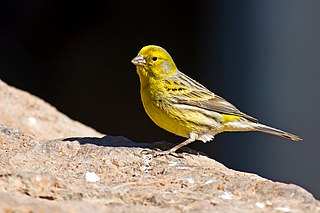
The Atlantic canary, known worldwide simply as the wild canary and also called the island canary, common canary, or canary, is a small passerine bird belonging to the genus Serinus in the true finch family, Fringillidae. It is native to the Canary Islands, the Azores, and Madeira. It has two subspecies: Wild canary or common canary and domestic canary. Wild birds are mostly yellow-green, with brownish streaking on the back. The species is common in captivity and a number of colour varieties have been bred.

The Guanche were the indigenous inhabitants of the Spanish Canary Islands, located in the Atlantic Ocean some 100 kilometres (60 mi) to the west of modern Morocco and the North African coast. The islanders spoke the Guanche language, which is believed to have been related to the Berber languages of mainland North Africa; the language became extinct in the 17th century, soon after the islands were colonized.

The laurel pigeon or white-tailed laurel pigeon is a species of bird in the Columba genus in the family Columbidae. It is endemic to the Canary Islands, Spain, and resides in laurel forest habitat. It is the animal symbol of the island of La Gomera.
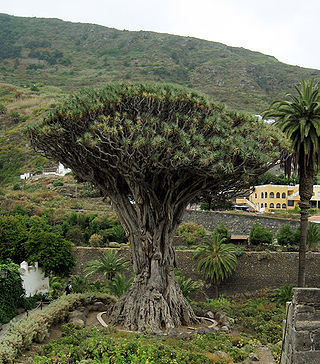
Dracaena draco, the Canary Islands dragon tree or drago, is a subtropical tree in the genus Dracaena, native to the Canary Islands, Cape Verde, Madeira, western Morocco, and possibly introduced into the Azores.

Atractylis is a genus of plants in the family Asteraceae.

Argyranthemum is a genus of flowering plants belonging to the family Asteraceae. Members of this genus are sometimes also placed in the genus Chrysanthemum.

Juniperus cedrus, the Canary Islands juniper, is a species of juniper, native to the western Canary Islands and Madeira, where it occurs at altitudes of 500–2400 m. It is closely related to Juniperus oxycedrus of the Mediterranean region and Juniperus brevifolia of the Azores.
Navegacion y Servicios Aéreos Canarios, better known by its initialism NAYSA, was a regional airline based in Las Palmas, Gran Canaria, Spain. It operated scheduled and charter flights, as well as cargo flights, air taxis, air ambulance flights and crew transfers. Its main base was Gran Canaria International Airport.

Micromeria is a genus of flowering plants in the mint family, Lamiaceae, widespread across Europe, Asia, Africa, and North America, with a center of diversity in the Mediterranean region and the Canary Islands. It is sometimes placed within the genus Satureja. The name is derived from the Greek words μῑκρος (mīkros), meaning "small," and μερίς (meris), meaning "portion," referring to the leaves and flowers. Common names include savory and whitweed.
Lauria fanalensis is a species of land snail in the family Lauriidae. It is native to Madeira and the Canary Islands.

Senecio glaucus is an annual member of the Asteraceae and species of the genus Senecio. It is found from the western Mediterranean to Central Asia in sandy, well-drained soil, particularly coastal and desert dunes.
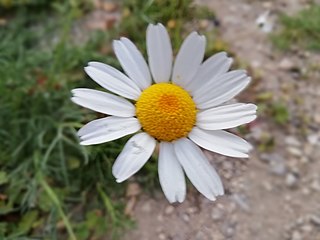
Argyranthemum frutescens, known as Paris daisy, marguerite or marguerite daisy, is a perennial plant known for its flowers. It is native to the Canary Islands. Hybrids derived from this species are widely cultivated as ornamental plants in private gardens and public parks in many countries, and have naturalized in Italy and southern California. There are many cultivars, but the most common has white petals.
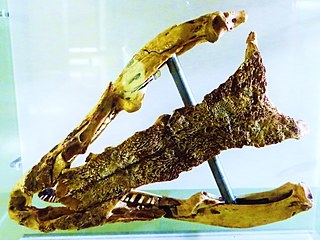
Gallotia goliath is an extinct giant lizard species from the island of Tenerife of the Canary Islands, Spain. This reptile lived before the arrival of humans and is believed to have grown to at least 0.9 metres (3.0 ft) long. It was described by the German herpetologist Robert Mertens. Fossils of this lizard have been found in volcanic caves, where they often appear with those of other animals, like the Tenerife giant rat.

The La Palma chaffinch, also known as the Palman chaffinch or, locally in Spanish as the pinzón palmero or pinzón hembra, is a small passerine bird in the finch family Fringillidae. It is a subspecies of the common chaffinch that is endemic to La Palma in the Canary Islands, a Spanish archipelago that forms part of Macaronesia in the North Atlantic Ocean.
The scientific name Euphorbia obtusifolia has been used for at least three species of Euphorbia:
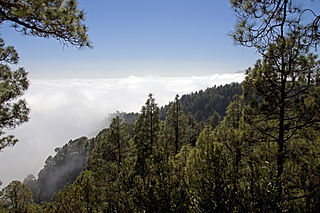
The Canary Islands dry woodlands and forests is a Mediterranean forests, woodlands, and scrub ecoregion in the Canary Islands. It encompasses the western group of the Canary Islands – La Palma, El Hierro, La Gomera, Tenerife, and Gran Canaria – in the Atlantic Ocean. These volcanic islands are an autonomous community of Spain, and lie southwest of the Spanish mainland and west of the North African coast.
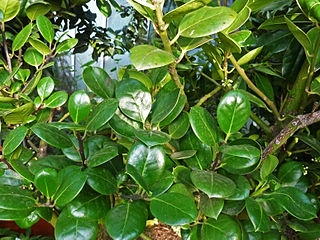
Ilex perado, the Macaronesian holly, is a species of holly endemic to Macaronesia, distributed throughout the Azores, Madeira and Canary islands. It is an important component of the natural high-altitude Macaronesian rainforest, known as 'laurisilva', found mostly at 500 to 1,200 m altitude but it also appears in forest formations at lower elevation. Many of the subspecies have been classified as threatened, probably because of very small population sizes, and are protected by local, national and regional legislation.















